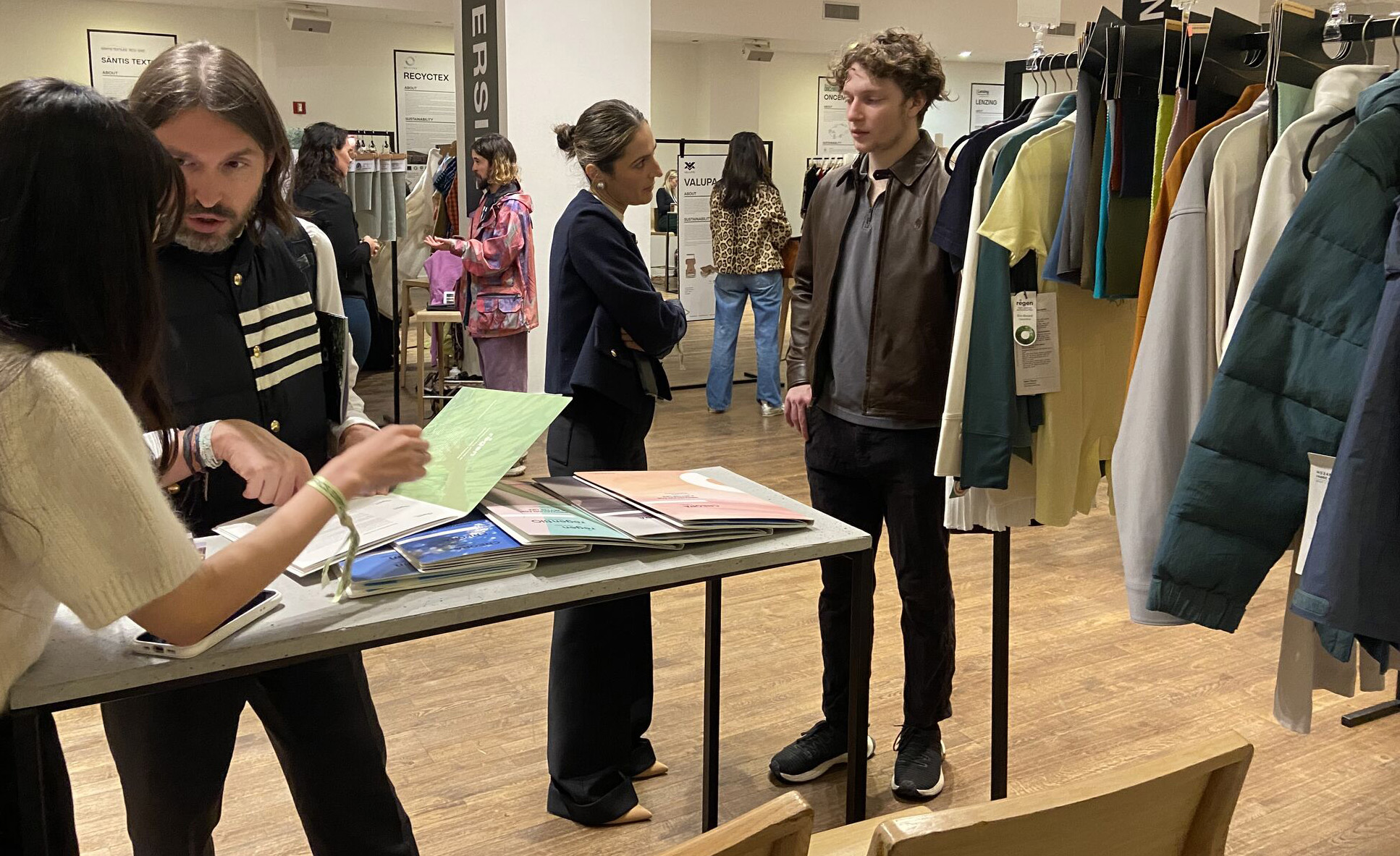
Call it Next-Generation, or the Age of Eco-Alternatives or A New Day for Innovation, but whatever the label, new cutting-edge, eco-forward developments are generating considerable buzz about the future direction of the textile industry. Fresh takes on entire systems are being explored. Execs are grappling to make circularity a reality, transparency mandatory and de-carbonization central to decision-making. Fiber innovation is fast and furious.
The energy and excitement around today’s responsible textiles was felt keenly at The Future Fabrics Expo held recently in New York City. Attendees, consisting of brands, designers and creatives all along the supply chain, clustered around pilot and early-stage projects in the Innovation Corner and filled seminar sessions to standing room only capacity. A Curated Textiles Area featured an extensive collection of certified, sustainably and responsibly-produced materials. Eco-alternative leathers, firms dedicated to regenerative farming practices and sophisticated natural fibers blends drew praise. A mix of international and U.S. suppliers and mills exhibited in a patchwork of small booths.
Taking place for just the second time in NYC, and its Seminar Series debut, Future Fabrics Expo (FFE) is laser-focused on innovation, education and community. New avenues for sustainable sourcing, low-impact processes and how to quicken commercial viability were main topics of conversation during the two-day trade fair. Organizers of the event, UK-based The Sustainable Angle, describe FFE NYC as “more than a sourcing destination; it’s a call-to-action.”
Future Fabrics Expo originated in London and has grown exponentially there. The New York show is significantly smaller in scale and scope in comparison, though to be fair, the London event has a 13-year head start.
“It’s a twofold situation happening with the future fabrics space,” shared Malvina Hoxha, U.S. marketing director at Hyosung. “It showcases both material evolution and consumption evolution. On the personal level, sustainability is getting stronger and on the textile level more companies are connecting the dots. How to scale, how to make, how to build partnerships and how to boost investment is the broader conversation.”
FFE is the right space for Hyosung to exhibit, explained Hoxha. “We’re making great strides in innovation and making an investment in the future of Hyosung.” Hyosung’s newest developments included RCS-certified, 100 percent recycled regen Spandex made from reclaimed waste from its production process and regen BIO Spandex made from renewable resources.. During the show a cohort of designers from Faherty, Theory and Ralph Lauren stopped by the Hyosung booth, along with an assortment of start-ups and students from nearby universities.

Getting Rid of Plastics
Amidst a myriad of newness at the show, Simplifyber stood out as offering a new way forward in a manufacturing process. “What injection molding did for plastics, Simplifyber is doing for natural fiber based soft goods,” stated Maria Intscher-Owrang, Simplifyber CEO, during a panel on bringing innovation to market. She added, “What our team is doing is shifting the status quo of a huge industry.”
Based in Raleigh, NC, Simplifyber is vertically integrated with its own supply chain from start to finish. It begins in a lab with liquids made from natural cellulosic fibers. Instead of spinning, weaving, cutting and sewing, the Simplifyber manufacturing platform accepts a wide range of natural inputs from FSC-certified wood, to recycled textiles, to agricultural and post-consumer waste. By pouring the material slurry into a system of molds, both the material and manufacturing processes combine to create products from footwear to dashboards for cars.
The Simplifyber process uses less water, replaces a chunk of the traditional textile system and the product is cost-competitive with plastics, according to Intscher-Owrang, who wore a pair of eye-catching Simplifyber shoes made in partnership with European brand Ganni.

Dealing with Hype and Hurdles
Frustration about next-gen materials being overly publicized, alongside worry about whether the category can live up to expectations, was a hot topic at the event. Intscher-Owrang weighed in: “The hype has been great. Not long ago no one knew about sustainable fashion. But hype with the general public is tricky. Sustainability is complex. Sustainability is not a soundbite.”
Innovators face challenges to achieve growth and commercialize. Price sensitivity about materials made from waste is a hurdle, along with re-assessing market strategies. Hannes Schoenegger, CEO, Bananatex, stated, “We need to keep doing our work. But when brands try to ‘boil the ocean’ it won’t succeed. You must pick a lane and be really good at one thing.”
Responsible materials makers cannot go it alone. The community will have to find a way to co-exist within the textile eco-system; That’s the key to future growth.


.svg)